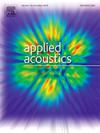Estimation of vibro-acoustic boundary conditions based on an experimental acoustic two-port characterization of a flexible flow duct
IF 3.4
2区 物理与天体物理
Q1 ACOUSTICS
引用次数: 0
Abstract
For the accurate numerical prediction of the vibro-acoustic interactions in flow ducts, correct structural boundary conditions modeling the joints of flexible duct walls are key in the low frequency region. Therefore, a more elaborated model than the standard simply-supported or clamped conditions is needed. Robin boundary conditions allow a better approximation, although they introduce additional parameters of which the concrete values are unknown. In this paper, an indirect methodology is proposed to estimate these parameters, using two-port data obtained from acoustic measurements as reference for iterative optimization. As the two-port method is independent of the acoustic boundary conditions at the duct in- and outlet, the indirect methodology is useful for early-design phases when the whole duct system is unknown. To illustrate the proposed methodology, a flexible duct segment is tested and modeled with the finite element method. The structural boundary conditions are parametrized with frequency-independent stiffness and damping coefficients for linear spring-damper combinations. Non-uniform, mesh-independent distributions along the boundary are used and the pretension imposed by the joint is included. Optimization leads to parameter values improving the match with the reference data compared to standard boundary conditions. An experimental Operational Modal Analysis validates that the optimized numerical model not only approximates well the two-port data, but also captures the underlying vibro-acoustic physics, making the updated model valuable for vibro-acoustic predictions. To demonstrate the robustness of the methodology, a parameter study is conducted with numerical reference data, which shows that the structural boundary estimation is independent of structural material properties.
求助全文
约1分钟内获得全文
求助全文
来源期刊

Applied Acoustics
物理-声学
CiteScore
7.40
自引率
11.80%
发文量
618
审稿时长
7.5 months
期刊介绍:
Since its launch in 1968, Applied Acoustics has been publishing high quality research papers providing state-of-the-art coverage of research findings for engineers and scientists involved in applications of acoustics in the widest sense.
Applied Acoustics looks not only at recent developments in the understanding of acoustics but also at ways of exploiting that understanding. The Journal aims to encourage the exchange of practical experience through publication and in so doing creates a fund of technological information that can be used for solving related problems. The presentation of information in graphical or tabular form is especially encouraged. If a report of a mathematical development is a necessary part of a paper it is important to ensure that it is there only as an integral part of a practical solution to a problem and is supported by data. Applied Acoustics encourages the exchange of practical experience in the following ways: • Complete Papers • Short Technical Notes • Review Articles; and thereby provides a wealth of technological information that can be used to solve related problems.
Manuscripts that address all fields of applications of acoustics ranging from medicine and NDT to the environment and buildings are welcome.
 求助内容:
求助内容: 应助结果提醒方式:
应助结果提醒方式:


